Compressive Mechanical Properties of Larch Wood in Different Grain Orientations
Abstract
:1. Introduction
2. Material and Methods
2.1. Materials
2.2. Test Method
3. Results and Discussion
3.1. Load–Displacement Curve
3.2. Failure Mode
3.3. Energy Absorption Characteristics of Wood under Compression Load
3.4. Strain Field Analysis
4. Conclusions
- (1)
- The load–displacement curves of larch wood in each grain direction contained elasticity, failure, and strengthening stages. The compressive strength in the longitudinal direction was 9.77 and 7.78 times those in the radial and tangential directions, and the elastic modulus in longitudinal direction was 6.96 and 10.94 times of those in the radial and tangential direction, respectively;
- (2)
- The failure modes of the compression in the longitudinal direction were mainly fiber buckling, fiber separation, and fiber fracture; the failure modes in the radial direction were mainly cellular compactness and accordion-like deformation; the failure modes in tangential direction were mainly growth ring buckling deformation and shear slippage between growth rings;
- (3)
- The energy absorption in the longitudinal direction was higher than in the radial and tangential directions. The energy absorption efficiency in the longitudinal direction was 1.91 and 3.64 times those in the radial and tangential directions, respectively;
- (4)
- The strain change in the longitudinal direction was smaller than those in the radial and tangential directions. In addition, the shear strain increased significantly in the yield stage.
Author Contributions
Funding
Institutional Review Board Statement
Informed Consent Statement
Data Availability Statement
Conflicts of Interest
References
- Wu, Y.Q. Newly advances in wood science and technology. J. Cent. South Univ. For. Technol. 2021, 41, 1–28. [Google Scholar] [CrossRef]
- Zhong, W.Z.; Rusinek, A.; Jankowiak, T.; Huang, X.; Abed, F. Experimental and Numerical Investigation on Compression Orthotropic Properties of Spruce Wood in Axial and Transverse Loading Directions. Eng. Trans. 2014, 62, 381–401. [Google Scholar]
- Ishikura, Y.; Matsumoto, K.; Ohashi, Y. Radial variation in partial compression properties perpendicular to the grain of Japanese larch (Larix kaempferi). J. Inst. Wood Sci. 2012, 58, 399–407. [Google Scholar] [CrossRef]
- Liu, F.L.; Jiang, F.; Zhang, J.Z.; Zhang, H.J.; Wang, X.P.; Yang, Z.H. Twelve Elastic Constant Values of Larch Forest. J. Northwest For. Univ. 2015, 30, 227–231. [Google Scholar] [CrossRef]
- Gonçalves, R.; Trinca, A.J.; Pellis, B.P. Elastic constants of wood determined by ultrasound using three geometries of specimens. Wood Sci. Technol. 2014, 48, 268–287. [Google Scholar] [CrossRef]
- Reiterer, A.; Stanzl-Tschegg, S.E. Compressive behaviour of softwood under uniaxial loading at different orientations to the grain. Mech. Mater. 2001, 33, 705–715. [Google Scholar] [CrossRef]
- Valipour, H.; Khorsandnia, N.; Crews, K.; Foster, S. A simple strategy for constitutive modelling of timber. Constr. Build. Mater. 2014, 53, 138–148. [Google Scholar] [CrossRef]
- Tao, J.L.; Jiang, P.; Yu, Z.S. Study on constitutive relation of wood under static compression and large deformation. Mech. Eng. 2000, 22, 25–27. [Google Scholar] [CrossRef]
- Yoshihara, H. Prediction of the off-axis stress-strain relation of wood under compression loading. Eur. J. Wood Wood Prod. 2009, 67, 183–188. [Google Scholar] [CrossRef]
- Tabarsa, T.; Chui, Y.H. Stress-strain response of wood under radial compression. Part I. Test method and influences of cellular properties. Wood Fiber Sci. 2000, 32, 144–152. [Google Scholar]
- Wei, Y.; Ji, X.; Duan, M.; Li, G. Flexural performance of bamboo scrimber beams strengthened with fiber-reinforced polymer. Constr. Build. Mater. 2017, 142, 66–82. [Google Scholar] [CrossRef]
- Chen, G.; Yu, Y.; Li, X.; He, B. Mechanical behavior of laminated bamboo lumber for structural application: An experimental investigation. Eur. J. Wood Prod. 2020, 78, 53–63. [Google Scholar] [CrossRef]
- Benabou, L.; Sun, Z. Numerical study of anisotropic failure in wood under large deformation. Mater. Struct. 2015, 48, 1977–1993. [Google Scholar] [CrossRef]
- Benabou, L. Predictions of compressive strength and kink band orientation for wood species. Mech. Mater. 2010, 42, 335–343. [Google Scholar] [CrossRef]
- Poulsen, J.S.; Moran, P.M.; Shih, C.F.; Byskov, E. Kink band initiation and band broadening in clear wood under compressive loading. Mech. Mater. 1997, 25, 67–77. [Google Scholar] [CrossRef]
- Oudjene, M.; Khelifa, M. Finite element modelling of wooden structures at large deformations and brittle failure prediction. Mater. Des. 2009, 30, 4081–4087. [Google Scholar] [CrossRef]
- Bodig, J. The effect of anatomy on the initial stress-strain relationship in transverse compression. For. Prod. J. 1965, 15, 197–202. [Google Scholar]
- Meng, X.J.; Chen, J.Y.; Shi, X.W.; Niu, Q.F.; Wei, J.W.; LI, T.Y. An experimental study of the wood performance under whole section compression in the transverse direction. China Sciencepap. 2016, 11, 62–65. [Google Scholar] [CrossRef]
- Gong, M.; Smith, I. Effect of load type on failure mechanisms of spruce in compression parallel to grain. Wood Sci. Technol. 2004, 37, 435–445. [Google Scholar] [CrossRef]
- Da Silva, A.; Kyriakides, S. Compressive response and failure of balsa wood. Int. J. Solids Struct. 2007, 44, 8685–8717. [Google Scholar] [CrossRef]
- Gindl, W.; Müller, U.; Teischinger, A. Effects of cell anatomy on the plastic and elastic behaviour of different wood species loaded perpendicular to grain. Iawa J. 2003, 24, 117–128. [Google Scholar] [CrossRef]
- Wang, R.; Shi, J.J.; Xia, M.K.; Li, Z. Rolling shear performance of cross-laminated bamboo-balsa timber panels. Constr. Build. Mater. 2021, 299, 123973. [Google Scholar] [CrossRef]
- Bakr, K.; Aydemir, D.; Bardak, T. Dimensional stability and deformation analysis under mechanical loading of recycled PET-wood laminated composites with digital image correlation. J. Clean. Prod. 2021, 280, 124472. [Google Scholar] [CrossRef]
- Navaratnam, S.; Ngo, T.; Christopher, P.; Linforth, S. The use of digital image correlation for identifying failure characteristics of cross-laminated timber under transverse loading. Measurement 2020, 154, 124472. [Google Scholar] [CrossRef]
- Meng, X.J. Experimental Study on The Wood Compression Properties forAncient Buildings’ Protection. Master’s Thesis, Taiyuan University of Technology, Taiyuan, China, 2016. [Google Scholar]
- Benabou, L. Kink band formation in wood species under compressive loading. Exp. Mech. 2008, 48, 647–656. [Google Scholar] [CrossRef]
- Zhang, L. Experimental Study on the Mechanical Properties of Wood and the Numerical Modeling Strategies of Wood. Master’s Thesis, Beijing Jiaotong University, Beijing, China, 2017. [Google Scholar]
- Cao, L.F.; Chen, J.Y.; Niu, Q.F.; Shi, X.W.; Li, T.Y. Experimental study on local compression performance perpendicular to the grain for five different woods. China Sciencepap. 2016, 11, 1452–1456. [Google Scholar] [CrossRef]
- Xu, Z.Y.; Xu, D.L.; Jia, C.; Zhou, Z.B. Energy Absorption Characteristics of Hard Pine during Across-compression. Packag. Eng. 2014, 35, 11–14. [Google Scholar]
- Xie, R.Z.; Guo, L.M.; Li, S.K.; Zhang, B.; Zhong, W.Z. Investigation of Quasi-static Compression Mechanical Properties of Populus Tomentosa. Equip. Environ. Eng. 2021, 18, 106–112. [Google Scholar] [CrossRef]



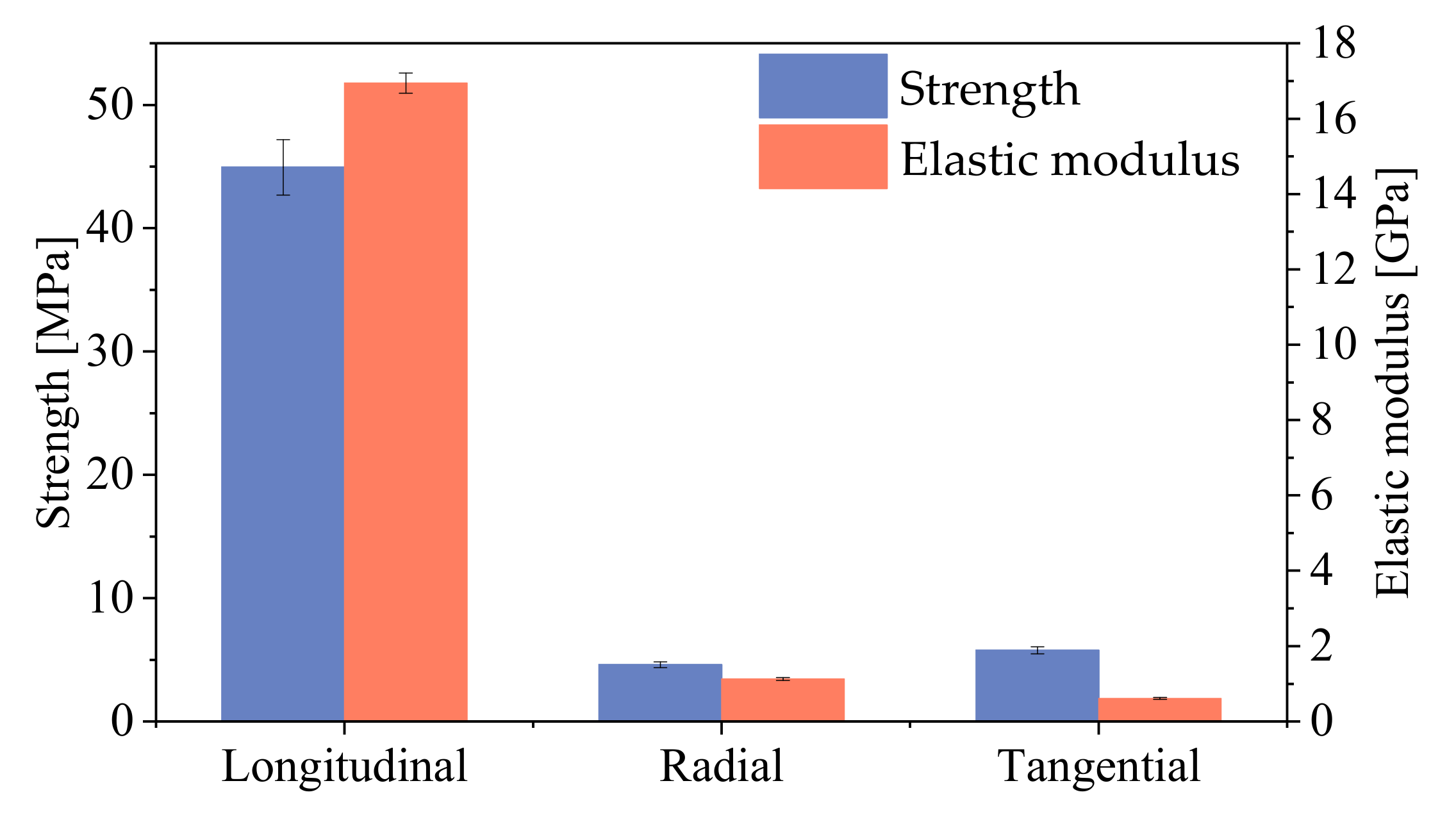
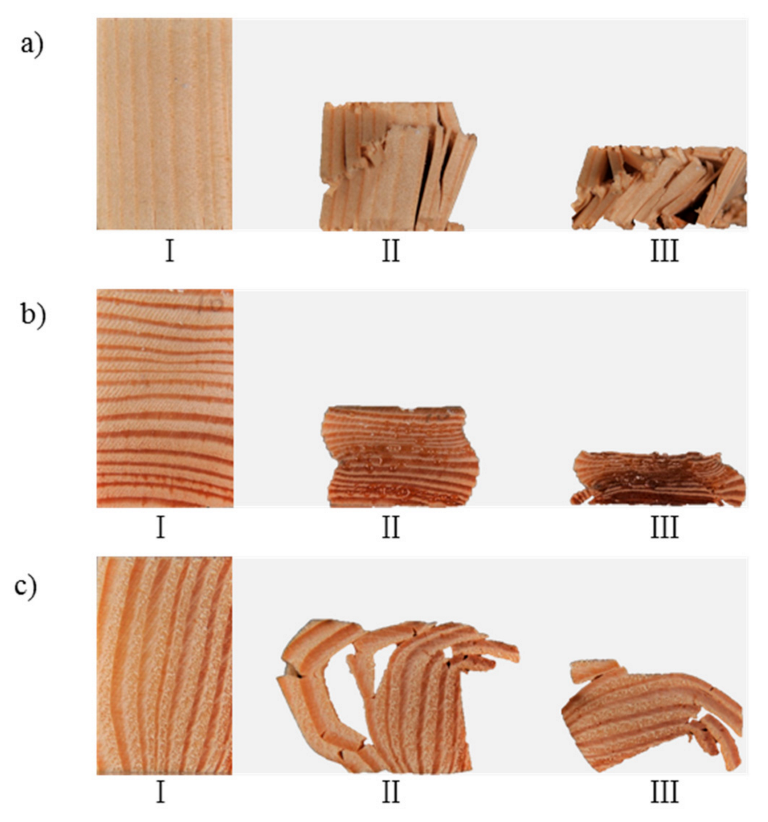
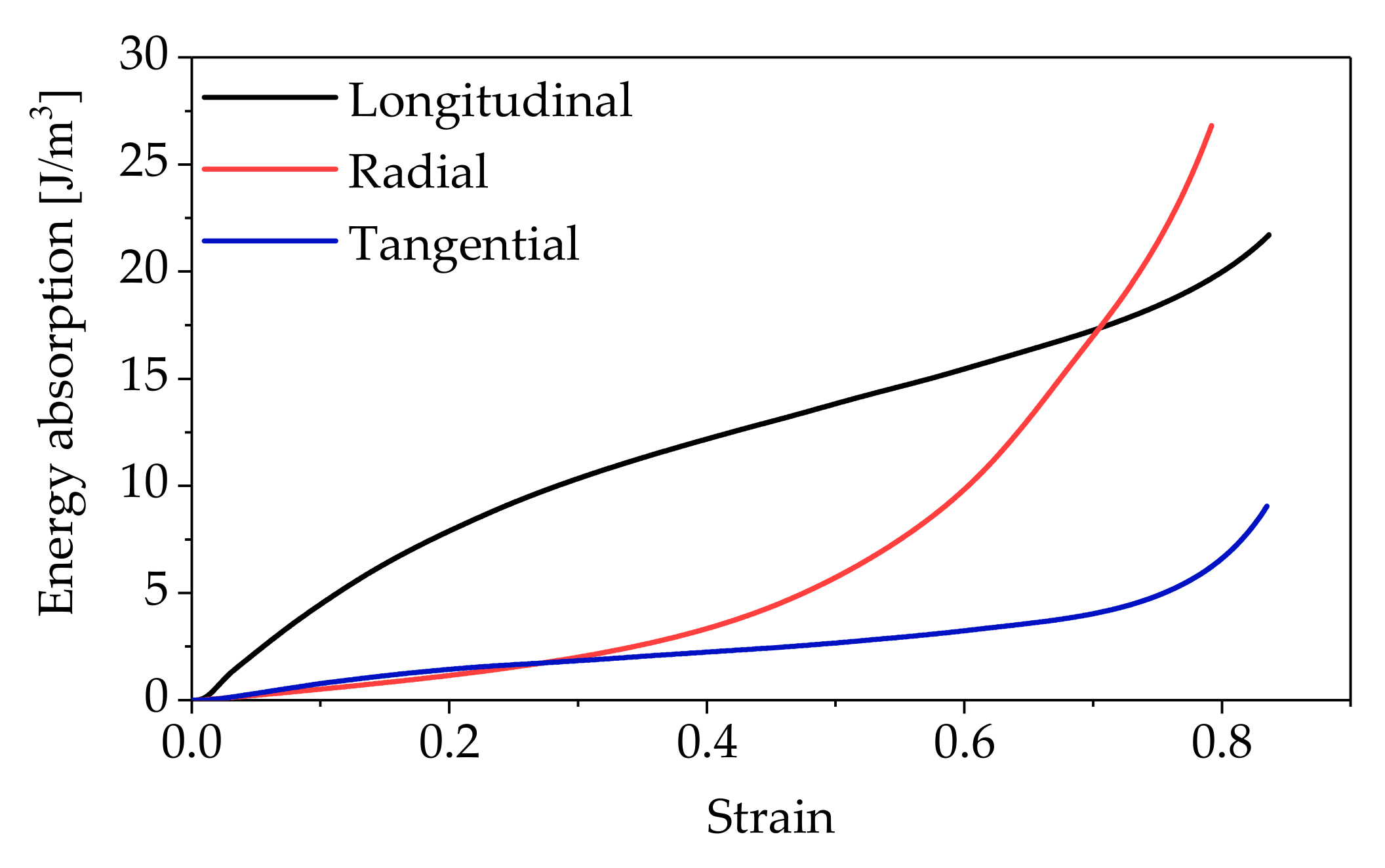
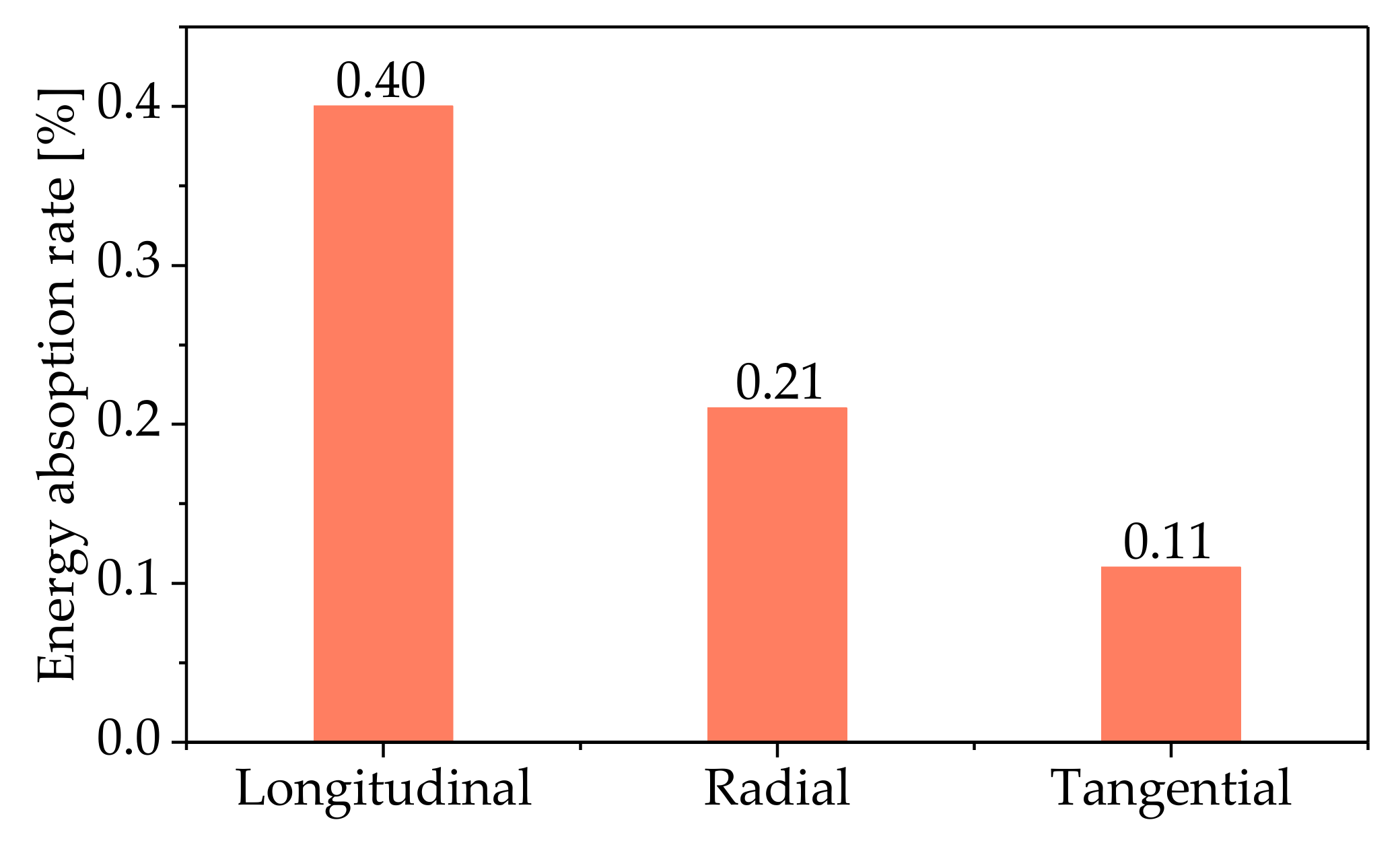
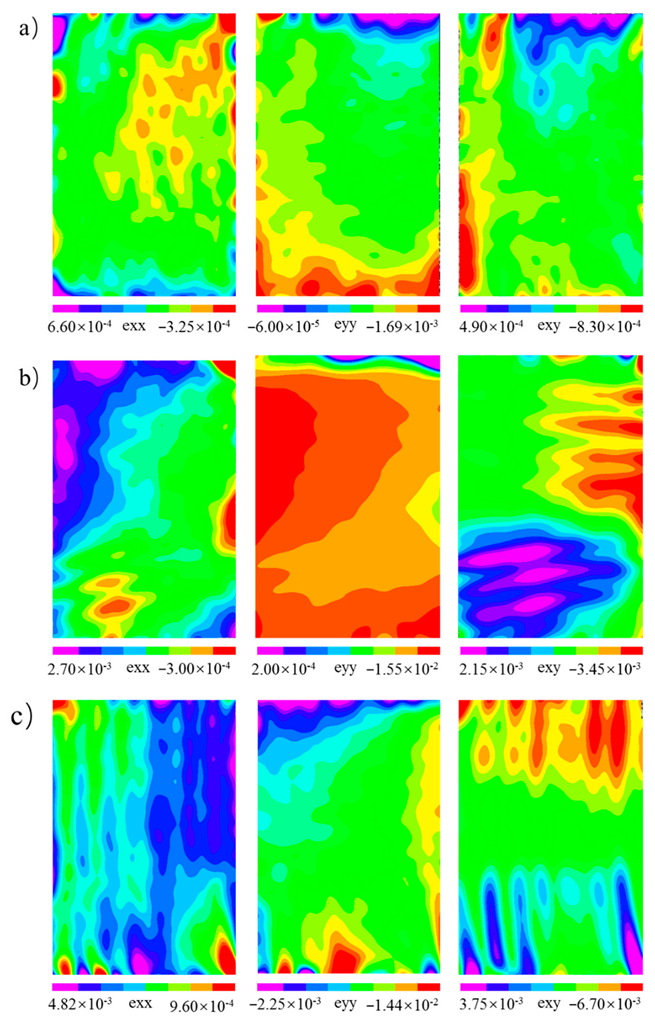

Publisher’s Note: MDPI stays neutral with regard to jurisdictional claims in published maps and institutional affiliations. |
© 2022 by the authors. Licensee MDPI, Basel, Switzerland. This article is an open access article distributed under the terms and conditions of the Creative Commons Attribution (CC BY) license (https://creativecommons.org/licenses/by/4.0/).
Share and Cite
Sun, J.; Zhao, R.; Zhong, Y.; Chen, Y. Compressive Mechanical Properties of Larch Wood in Different Grain Orientations. Polymers 2022, 14, 3771. https://doi.org/10.3390/polym14183771
Sun J, Zhao R, Zhong Y, Chen Y. Compressive Mechanical Properties of Larch Wood in Different Grain Orientations. Polymers. 2022; 14(18):3771. https://doi.org/10.3390/polym14183771
Chicago/Turabian StyleSun, Jingcheng, Rongjun Zhao, Yong Zhong, and Yongping Chen. 2022. "Compressive Mechanical Properties of Larch Wood in Different Grain Orientations" Polymers 14, no. 18: 3771. https://doi.org/10.3390/polym14183771
APA StyleSun, J., Zhao, R., Zhong, Y., & Chen, Y. (2022). Compressive Mechanical Properties of Larch Wood in Different Grain Orientations. Polymers, 14(18), 3771. https://doi.org/10.3390/polym14183771






